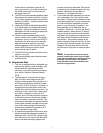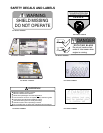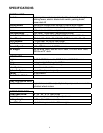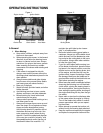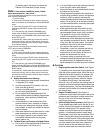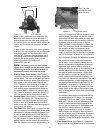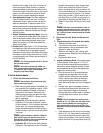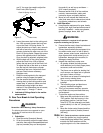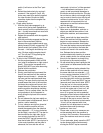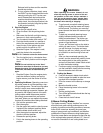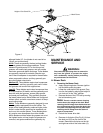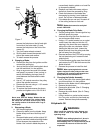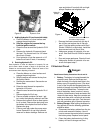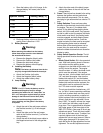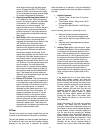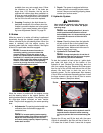15
switch (it will return to the “Run” posi-
tion).
4. Retard the choke slowly by moving it
rearward. If the engine is “cold”, the
choke may need to be partially applied
for a few minutes. Be sure to totally
retard the choke after the engine has
“warmed up”.
g. Check safety devices:
1. With the park brake engaged, try to
move one of the lap bars (speed/direc
-
tional control) from the neutral/start posi-
tion — the lap bars should not move with
the park brake engaged.
2. Repeat this procedure with the opposite
side lap bars.
3. With the park brake engaged and the lap
bars in the neutral/start position,
advance the engine speed control com
-
pletely forward (Hi-idle), engage the PTO
control switch (pull upward), then lift off
the seat — the engine should stop run
-
ning. Sit down and the engine should
run. Turn off the PTO by pushing the
control switch down.
h. To drive in the FORWARD direction:
1. Set the engine speed to 2000 to 2500
rpm (refer to tachometer on right control
panel). This must be increased to full
speed (3525-3675 rpm) after becoming
familiar with the machine.
2. Release the park brake.
3. Slowly, move both lap bars toward the
front of the machine until the machine
begins to move forward — release the
lap bars and the machine should stop
moving. The more that the lap bars are
moved toward the front of the machine,
the faster the machine will move in the
forward direction. Release the lap bars
and the machine should stop traveling
forward. (This is a safety check, the nor
-
mal procedure is for the operator to
slowly bring the lap bars to the neutral
position).
4. Do not advance the lap bars rapidly as
this could cause turf defacement, loss of
traction, and/or instability.
5. To turn, advance one lap bar ahead of
the other and the machine will turn
toward the opposite from the side that
was advanced — I.E. to turn clockwise
(to the Right), move the LEFT lap bar for
-
ward more than the right side, and to
turn counter-clockwise (to the LEFT),
move the RIGHT lap bar forward more
than the left side. NOTE: If one lap bar is
in the neutral position and the other is
advanced, the turn side tire will not
rotate and a “pivot turn” will be executed
— turf defacement could occur (if on
grass) as well as potential damages to
the traction surface and the tire. If the lap
bar on the turn side is not brought all the
way to neutral, then the turn side tire will
continue to rotate and a “U-turn” will be
executed with a low potential for turf
defacement as well as traction surface
and tire damage.
i. To drive in the REVERSE direction:
1. Make sure no bystanders, animals, or
objects are behind the machine. Look
behind the machine, and use extreme
care.
2. Slowly, move both lap bars toward the
rear of the machine until the machine
begins to move rearward. Release the
lap bars and the machine should stop.
The more the lap bars are moved toward
the rear of the machine, the faster the
machine will move in the reverse direc
-
tion. Release the lap bars and the
machine should stop traveling in reverse
(this is a safety check, the normal proce
-
dure is for the operator to slowly bring
the lap bars to the neutral position).
3. Do not retard the lap bars rapidly as this
could cause turf defacement and/or loss
of traction.
4. To turn, retard one lap bar ahead of the
other and the machine will turn toward
the same side that was retarded — I.E.,
to turn counter-clockwise (to the LEFT),
move the LEFT lap bar rearward more
than the right side, and to turn clockwise
(to the RIGHT), move the RIGHT lap bar
rearward more than the left side. NOTE:
If one lap bar is in the neutral position
and the other is retarded, the turn side
tire will not rotate and a “pivot turn” will
be executed. Turf defacement could
occur (if on grass) as well as potential
damages to the traction surface and the
tire. If the lap bar on the turn side is not
brought all the way to neutral, then the
turn side tire will continue to rotate and a
“U-turn” will be executed with a low
potential for turf defacement as well as
traction surface and tire damage.
j. To perform a “zero turn”:
1. Please note, a zero turn maneuver can
not be executed while the machine is
moving in the Forward or, Reverse direc
-
tions, the machine must come to a stop
first.
2. To turn clockwise, slowly move the LEFT
lap bar forward while simultaneously
moving the RIGHT lap bar rearward.



